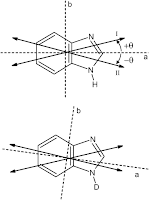- the probability that a photon will be absorbed by a molecule which then makes a transition to an electronic excited state
- the polarisation of the light that is absorbed and emitted by the molecule
- the rate at which the excited state decays by emitting radiation
- the strength of the van der Waals interaction between pairs of the molecule
- FRET=Forster Resonant Energy Transfer, where an excited state can be transferred to a neighbouring molecule
Some of the relations and key references are in this paper I co-authored on Transition dipole strength of melanin.

What determines these transition dipole moments? How do we make them large?
A key aspect is that they involve delocalisation of charge in both the ground and excited state.
This becomes apparent in this extract from Nitzan's book which shows how the transition dipole moment is proportional to the distance between the two centres over which the charge is delocalised and the Hamiltonian matrix element between orbitals localised on these two centres.
The direction of the transition dipole moment tends to be parallel to a vector joining the two centres.

No comments:
Post a Comment